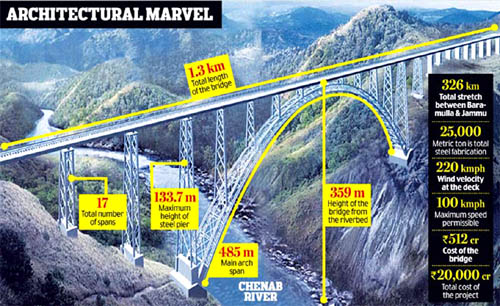A K Khanna
The Pir Panjal is outer range of the upper Himalayas forming Southern boundary of Kashmir. The state of J&K has three distinct geographical divisions -Jammu, Kashmir and Ladakh- with same characteristic feature of Unity in Diversity as in the other parts of India.
The invincible Chenab river channel formed by Mother Nature has been gradually bridged to connect the Kashmir valley by railway with rest of India.The history of railways in the State of Jammu & Kashmir goes back to 1897 when the railway track from Jammu to Sailkot (now in Pakistan) was first built. This was the first railway line in the erstwhile state of Jammu and Kashmir under Dogra rulers. The railway tack was abandoned after partition and people are living over the track now. The then railway station at Jammu was vandalized and converted into Warehouse wholesale market and Kala Kendra near the Vikram Chowk in Jammu city. How much do we care for our heritage?
In 1897, Maharaja Pratap Singh, the then Dogra ruler of the state explored the possibility of Railway line connecting Jammu with Kashmir valley (Srinagar). For various political reasons and complication with British Indian Government the project was put on hold. Indian British Govt. proposed to provide a rail link following the Jhelum river route in Kashmir valley connecting Srinagar to Rawalpindi (now in Pakistan) as most of the residents of state lived in Jammu and Srinagar.
Again in 1905 the British approached the Maharaja with a proposal for a link between Rawalpindi and Srinagar. Maharaja Pratap Singh approved a link between J&K via Reasi (Jammu region) through Mughal road. The tedious track line between Kashmir valley via Reasi through Mughal road route was to involve a 2ft (610mm) or 2ft 6 inches (762mm) narrow gauge railway line. If was planned it had to climb all the way to Mughal pass at 11000 ft (3353 M) over the Pir Panjal Range. It would have been electric powered track and would have used the mountains streams as a source of hydro electric power. It it was not at all weather railway tracks. It would have been a low.
Himalayan Toy train railway built in (1878-81) from Siliguri to Darjeeling, presently in operation as WORLD HERITAGE site.
Jammu-Udhampur-Srinagar Baramulla Railway link (345 Km) (214 miles) to Baramulla is on the northern west ridge of the Kashmir valley. The route crosses major earth quake zones and subjected to maximum variation of temperature of snow, cold and heat with inhospitable.
The 1.315 km long stain less steel cantilever bridge will consume 25000 toners of steel and will be an engineering marvel in the history of India Railways. The mighty river Chenab water channel will be bridged between Kauri village in Reasi district and village Bakkal on other side on the Dharam section of Udhampur.
On completion of the present Chenab River Bridge, the rail link would put rail connectivity to the Kashmir valley by passing Bhannihal pass road. The 1.315 km long railway bridge would attain a height of 359 m over the river bed. The Bridge will be taller then Eiffel tower of Paris the landmark of France. Presently, the world’s tallest rail bridge is in France on Tarn River with its tallest pillars rising to 340 m high.
The bridges will consume 25000 tonnes of stainless steel.Till now we have completed 25 present of the total work, stated a senior engineer on the site of the project.
According to the sources 75 percent of earth work/rock cutting have been completed on village Bakkal side on bank of the Chenab River and the same has been initiated on the village Kauri on other side.
The design of the cantilever bridge has been divided into three segments -a 467 m steel arch in the centre ,a 185m approach deck from Bakkal village end ,650 m approach from Kauri Village end. The bridge would emerge from single rail track tunnel on both sides. It has been so designed to accommodate a double track in future. The whole Cantilever structure work is supported by two 130 m long, 100m high pylons on either end and supported by steel cables.
The best available steel have been chosen to build the bridge as it can withstand the variation of temperature upto -20°C and wind speed of the Chenab valley above 200 km per hours.
The security and safety has been enhanced by using 63m thick special blast proof steel rods. The cement stone ballast concrete pillar of the bridges are designed to with stand explosions.
A wide range of electronic gadgets have to be utilized as security measures to safeguard the bridge. An on line monitoring and warning system also would be installed to protect the man and material. A foot path and cycle trail would also be provided. The type of paint approved by the RDSO (Research Defense Service Organization) is being procured from Japan which can withstand rain, snow, humidity and low temperature for at least 35 years while KRCL is premier executing agency.The bridge is being designed and constructed by Chenab Bridge Project Undertaking – a joint venture between AFCON,-Ultra Construction and Engineering Company from Korea and VSL India.
The joint venture has selected two design consultants WSP Consulting Kortes of Finland for bridge via ducts and for foundation Leoahart Andre and partners of Germany for main steel arch. Experts of various fields from 15 Indian Govt agencies including IIT,IISC, RSDO, DRDO,and equal number of foreign contractors are struggling with erecting this bridge on the Chenab River.
Trending Now
E-Paper


